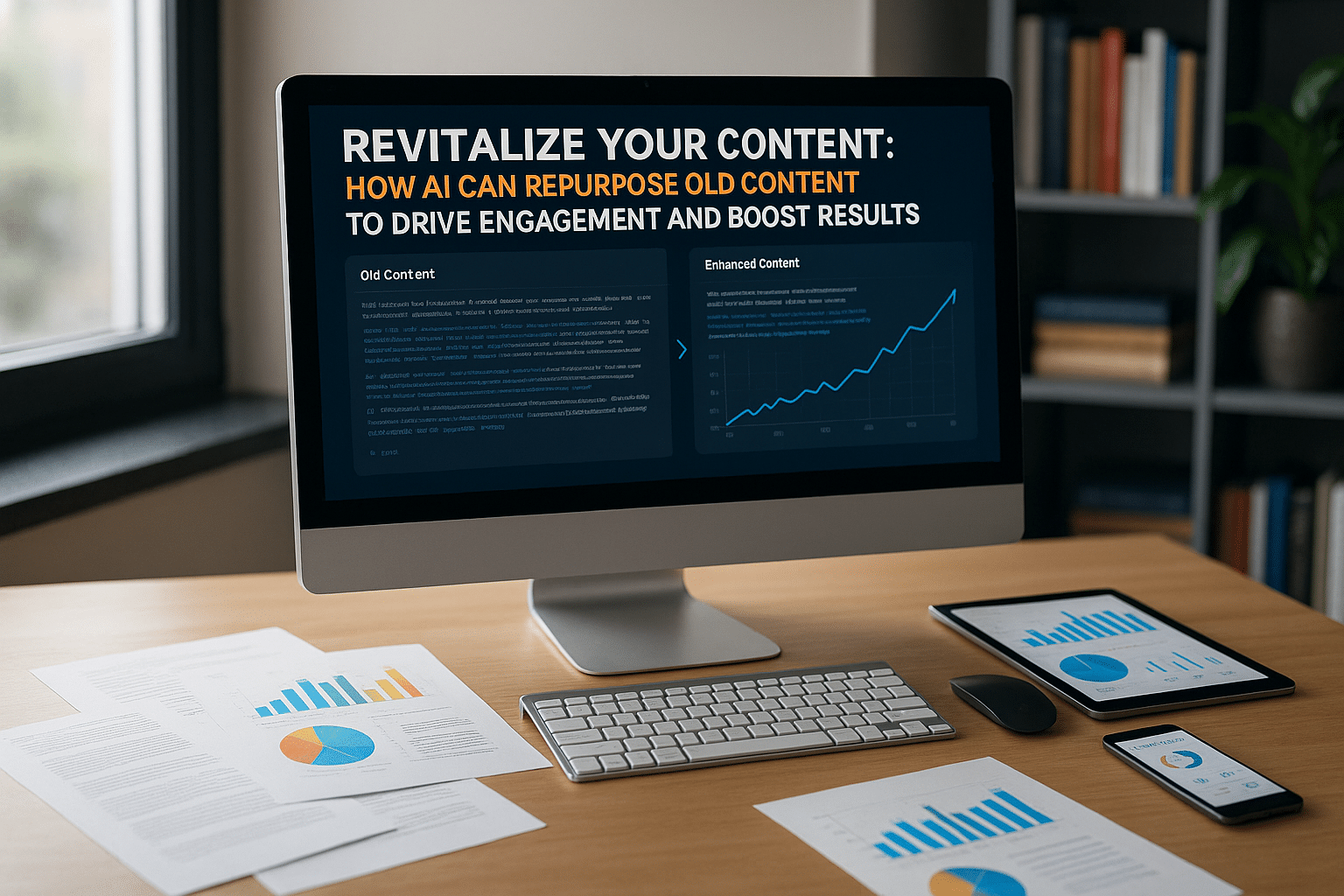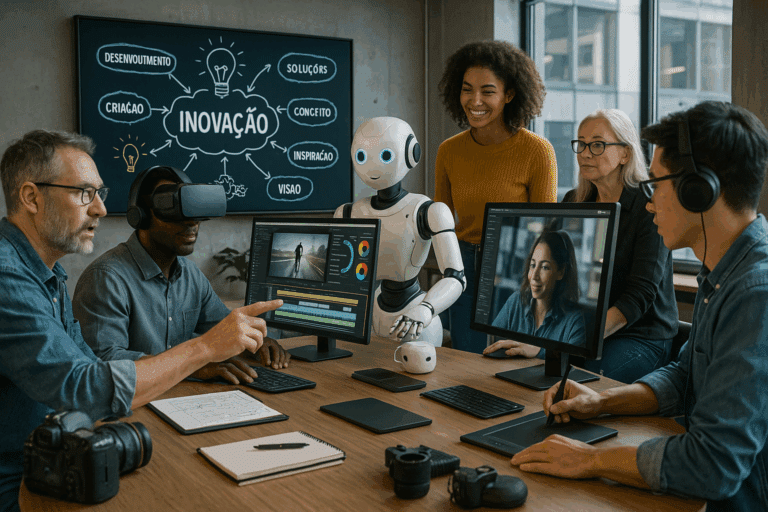It might seem logical – after all, who wants yesterday’s news? But what if we could breathe new life into that ‘outdated’ content, making it as relevant, engaging, and productive as when it first went live?
This is not merely a hypothetical scenario. With the advent of Artificial Intelligence (AI), such revitalization is not only possible but also remarkably efficient. This blog post will delve into the fascinating world of AI-driven content repurposing – a strategy that could dramatically transform your content marketing game. 🚀
Why Revitalize Old Content?
It’s easy to overlook the value of older content. However, consider this: your existing content already has a track record. You know how it performed, who it reached, and what kind of engagement it drove. Rather than starting from scratch, repurposing allows you to build on previous success, often with significantly less effort and resources. Moreover, updating your old content can significantly improve your search engine rankings, as search engines favor fresh, up-to-date content.
But how can AI help with this process? Let’s shed some light on this question. 🧐
The Role of AI in Content Repurposing
AI has the potential to transform content repurposing from a time-consuming task into a streamlined, automated process. It can analyze your old content, identify potential areas for improvement or update, and even generate new versions of the content tailored to different audiences or platforms.
For instance, AI can convert a blog post into a script for a podcast or video, ensuring your content reaches a broader audience. Or it could rephrase your content to target a different keyword, helping you to capitalize on new SEO opportunities without creating entirely new content. 🎯
Unlocking the Potential of AI for Content Repurposing
With its ability to analyze large volumes of data, generate human-like text, and learn from feedback, AI offers exciting possibilities for content repurposing. In the upcoming sections, we’ll explore how AI can help you repurpose your old content, from identifying the most promising pieces to tailoring updates to the latest SEO trends.
Prepare for a deep dive into the mechanics of AI-driven content repurposing. We’ll look at how AI tools can learn from your content, generate fresh updates, and even predict the performance of repurposed content. Moreover, we’ll touch on the practical aspects of implementing AI in your content strategy, including the best tools and practices to consider.
By the end of this read, you’ll have a firm grasp of how AI can breathe new life into your old content, amplifying your reach, engagement, and results. So, let’s get started on this journey towards supercharging your content marketing strategy with AI. 💡
Discovering the Power of AI: Breathing New Life into Your Content
Are you tired of your old content gathering digital dust? Do you want to find a way to reinvigorate your old pieces and have them driving traffic and engagement just like they used to? Look no further, because the solution is here, and it’s called Artificial Intelligence (AI). With its powerful machine learning capabilities, AI can help you repurpose your old content to reach and engage new audiences, driving results like never before.
AI, with its ability to analyze massive amounts of data and predict outcomes, has become an invaluable tool in content marketing. It can take your old, underperforming content and transform it into something fresh and exciting, tailored to what your audience wants and needs. But how does this process work? Let’s dive deeper into the mechanics of content revitalization through AI.
Revitalizing content is not about simply rehashing the same old material. It involves creating a new perspective, tweaking the narrative, and adding value. AI, with its data-driven insights and ability to generate human-like text, can help you achieve all this and more. It can analyze your old content, identifying what worked and what didn’t, and then use this information to create fresh, engaging content.
Content Analysis and AI: The Perfect Match
The first step in content revitalization is analysis. AI tools can crawl your entire content library, identifying patterns and trends. It can pinpoint pieces that performed well, pieces that didn’t, and the reasons why. This analysis can include everything from keyword usage and content length to readability and sentiment analysis.
Once the analysis is complete, the AI can use this information to create a content strategy. This strategy can include everything from topic suggestions and keyword recommendations to ideal content length and tone. The AI can also suggest the best format for your content, be it blog posts, videos, podcasts, or infographics.
One of the most potent AI tools for content analysis is IBM’s Watson. This powerful AI can analyze your content and provide actionable insights in real-time. For a quick introduction to Watson and its capabilities, check out the video “IBM Watson: How it Works” on the IBM YouTube channel.
Content Generation: AI at Work
Once the AI has analyzed your content and created a strategy, it’s time for the next step: content generation. AI tools, like OpenAI’s GPT-3, can generate human-like text based on the data they’ve gathered. They can create blog posts, social media updates, and even video scripts, all tailored to your audience’s preferences and interests.
One of the biggest advantages of AI content generation is its speed. It can generate content in a fraction of the time it would take a human writer, allowing you to keep up with the rapid pace of digital marketing. However, it’s important to remember that AI-generated content still requires human oversight. An AI can create a draft, but it’s up to you to add the finishing touches.
Interested in seeing AI content generation in action? Check out the video “GPT-3: A Revolution in AI” on the OpenAI YouTube channel.
AI Content Revitalization in Action: A Comparative Look
Let’s take a look at how AI content revitalization can transform your content marketing efforts. Here’s a simple comparative table:
| Before AI | After AI |
|---|---|
| Time-consuming content analysis | Fast, automated content analysis |
| Hit-or-miss content strategies | Data-driven content strategies |
| Slow content generation | Fast, efficient content generation |
| Static, unchanging content | Dynamic, adaptable content |
As you can see, AI can completely transform your content marketing efforts, making them more efficient, effective, and adaptable.
Embrace the Future: AI-Powered Content Revitalization
It’s time to stop letting your old content gather digital dust. With AI-powered content revitalization, you can give your old pieces a new lease on life, driving traffic, engagement, and results like never before.
From content analysis and strategy creation to content generation, AI can handle every step of the content revitalization process. It can transform your old, underperforming pieces into fresh, engaging content that your audience will love.
So why wait? Embrace the future of content marketing today. Let AI-powered content revitalization revolutionize your content strategy and boost your results. Remember, the future of content is here, and it’s powered by AI.

Conclusion
In conclusion, we have traversed a comprehensive journey into the intricate and fascinating world of Software Engineering and Information Technology. From the inception of a system, its design, implementation, testing, and maintenance, every stage of the software development life cycle is packed with complexity that demands a thorough understanding and expertise.
The heart of software engineering is the development of efficient and reliable software systems. Achieving such feats requires an in-depth knowledge of programming languages, data structures, algorithms, computer architecture, and more. We delved into the importance of various programming languages, from the versatile Python to the robust Java and the increasingly popular JavaScript. W3Schools provides an excellent resource to delve deeper into these languages and their respective intricacies.
Data structures and algorithms form the crux of efficient software systems. The choice between a linked list or an array, a quick sort or a bubble sort could be the difference between a fast, responsive application and a slow, frustrating one. We explored how understanding the time and space complexity of different algorithms can guide us in making these critical decisions.
We delved into the various stages of software development, starting from requirements gathering and system design to coding, testing, and maintenance. We emphasized on the importance of each stage and how skipping any one of them can lead to disastrous consequences. For more insights on the software development life cycle, I recommend visiting the Tutorials Point website.
We also touched upon the importance of documentation in software engineering. Proper documentation not only makes the life of a developer easier but also ensures the long-term maintainability of the software system. A well-documented software system is much easier to upgrade, debug, and maintain.
The software industry is rapidly evolving. New technologies and methodologies are continuously emerging, making it imperative for professionals to stay up-to-date. Reading industry-related blogs and articles, attending webinars and conferences, and participating in online communities are some of the ways to stay ahead of the curve.
Finally, I would like to emphasize the importance of continual learning and curiosity in the field of software engineering. The learning curve in this industry is steep, but the rewards are worth the effort. I hope that this article has been informative and insightful for you. Your feedback is highly appreciated, so feel free to leave your comments below. 😊
Sharing is caring! If you found this article helpful, please share it with your friends and colleagues. 🙌 And remember, as Bill Gates once said, “Software is a great combination between artistry and engineering.” So, keep learning, keep experimenting, and keep creating beautiful pieces of software.
References:
– W3Schools
– Tutorials Point
Stay tuned for more deep dives into the world of software engineering. Until next time, happy coding! 👨💻



